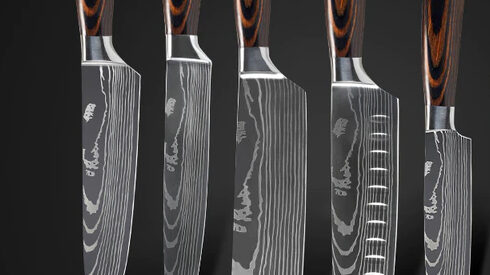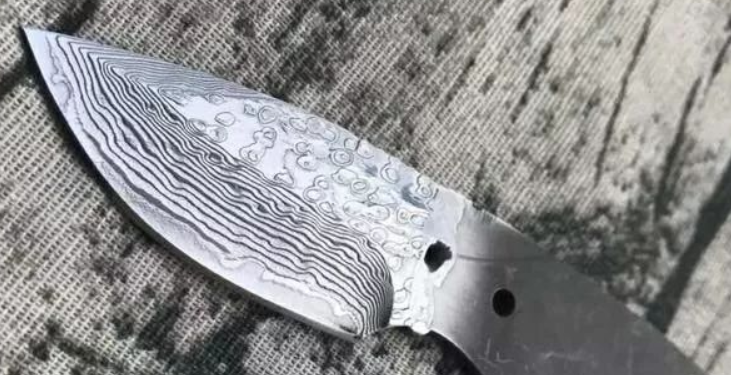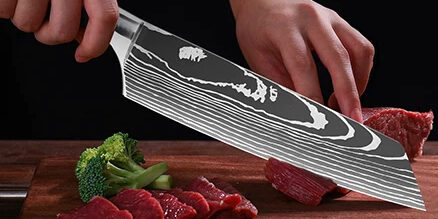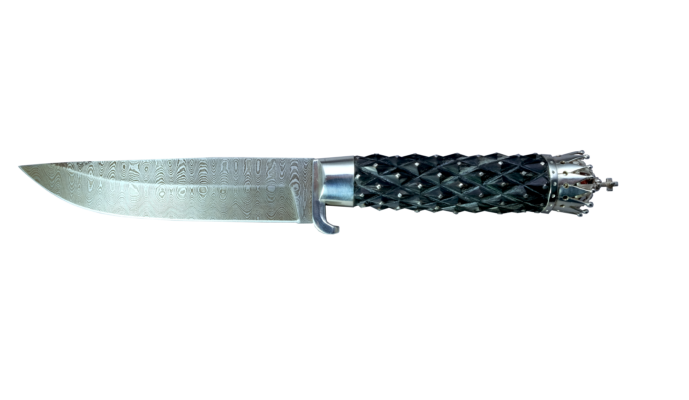Damascus from Asia and knives that pretend to be made of Damascus steel
False promises of perfect kitchen knives made of genuine Damascus. The market is flooded with Chinese and East Asian imitations. An outrage against the craftsmanship of Japanese and European blacksmiths.

Making good layered steels for kitchen knives is pure master craftsmanship.
For a chef’s knife suitable for the kitchen, a careful selection of different steels must be made. Steels that produce an elastically tough but hard steel.
Steel grades that simultaneously create a strong contrast between the shades of gray during etching.
Forging heat and cooling times must be individually observed.
Fire-welded layer steel without the corresponding insert steel is never homogeneous and really hard at the cutting edge.
What is produced here and in Japan, today in series in smaller quantities, is usually of high quality.
The forging and hardening processes are finely tuned and automated. The hot-dip welded layers are homogeneous and the steels are usually stainless.
This is naturally reflected in the price. High-end damask kitchen knives must always have an upscale price due to manual work, elaborate manufacturing processes and quality control.
Inexpensive Japanese-style chef’s knives are not forged. And not made using the classic Damascus process. They come from the rolling mills of large steel processors.
Traditional Japanese and European blacksmithing.
Traditionally, packs of two different steels are welded together. This is done under high heat and intensive forging with a hammer.
The forging drives the flux, borax or quartz out of the steel package. This is the only way to make the weld oxide-free and homogeneous.
The package is forged and folded over.
The contact surfaces are in turn welded together using an oxidation-preventing agent.
The package, which is folded several times in this way, is then forged into a blade. This is traditionally done by hand or with the help of a mechanical hammer, air hammer or spring hammer.
Industrial steel is far removed from the Japanese or European forging tradition
What the experienced blacksmith conjures up from forge and anvil with long manual labor, imagination and experience, the industry tries to imitate cheaply in automated processes.
The steels are welded using the rolling process, or joined together under pressure and heat in the absence of oxygen.
Folding is done by a bending machine. Twisting is done with machines. All of this is done in large quantities and without any manual labor.
This makes the steel cheaper to produce. However, the dream of the old, wise blacksmith who uses his traditional knowledge to produce super steels is over here.
Bottle fake Damascus knife steels from Asian productionIn recent years, online suppliers have been flooding us with cheap Damascus knives.
The low number of layers of the individual steel layers is striking and important for the customer to recognise this.
Overall, the knives are too thin and too unstable for proper use in the kitchen. We have seen knives whose layers are not welded through, where corrosion forms or small sharp edges that can cause injuries.
Or the flaws in the pattern have been welded shut afterwards, which creates small light-coloured spots in the picture.
Some of these knives follow the design and shape of the classic models from Japan, Santoku, Gyuto, Nakiri or Yanagiba. However, most of them are poor compromises, concessions to the European hype.
More like compromised hybrids than suitable knife shapes.
As already mentioned, the classic Japanese handle only makes sense and lasts if it follows Japanese tradition. This means seamlessly inserted blades in absolutely moisture-resistant woods.
Indispensable, stable ferrules on the handle.
The Asian epigone knives usually cannot guarantee this.
It’s a shame that the enthusiasm for Japanese, traditional cutting wonders is awakened and then replaced with this third-class fake, usually made in China, India or Pakistan.

East Asian fake knives, Damascus imitations and striped wallpaper on the blade.
Budget knives with a so-called Damascus look.
Windy dealers try to catch customers with the name Damascus look or -look etc.. to catch customers. Even more perfidious is three-ply Damascus with a Damascus look.
You would have to assume that you have something great in front of you that somehow corresponds to the much-praised properties of layered steel. No, that’s more of a deception. On the contrary. The look it creates is like faux wood on pressed cardboard.
There are several methods of creating an image on the surface of a kitchen knife that resembles the Damascus pattern, and all of them are short-lived.
The stripe pattern can be etched onto blades using a screen printing stencil. This is the same process that knife manufacturers use to apply their logo to knives.
This is not high-contrast, at most dark gray and does not last very long.
After coating with a special lacquer, the pattern can be burned into this lacquer with a laser.
This corresponds to burnt-on paint, lasts better, but is questionable in kitchen use.
There are knives on the market that are titanium-coated Titanium can be colored, from light yellow to dark blue. A light line pattern is subsequently applied to create a pattern reminiscent of damask.
Still the best method is to laser the pattern correctly using the temper marking process, which is abrasion-resistant and durable.
Assuming you have a laser that can mark such large areas and have the experience and background that TYPEMYKNIFE® has for this process.
That is highly doubtful.
And it remains fake… purely visual and has nothing to do with the composite steel pattern.
Three layers – fire-welded steel?
The wording three-layer steel sounds as if you were dealing with real Damascus steel. Because the number of layers is a certain quality criterion for this.
But there is no such thing as three layers of Damascus.
Be careful, the damask look of three layers of steel is so misleading that we can suspect bad intentions behind it!
I would like to say that you can tell a bad knife by its low price. But obviously a huge deal is being made from an insight. The customer recognizes the quality by the price. So the better it is to charge high prices for the bad knives so that it isn’t noticed. That makes the scam perfect.
Be sure to pay close attention to what high-quality damask kitchen knives are offered to you online. We are currently seeing a brutal flood of cheap and bad material, which is mainly advertised on social media with beautiful pictures and grandiose promises of quality.
Be especially careful if only a few knives are on offer, especially with very special colorful handles made of wood-acrylic resins or other unusual handle materials.
We at TYPEMKYNIFE® do not offer you a knife with this type of steel because our specialty is the individual laser design for kitchen knife blades from European blade production in our 3D engraving configurator.
If you need technical expertise on kitchen knives made of Damascus steel, please feel free to contact us.
TYPEMYKNIFE® Blog 2022


